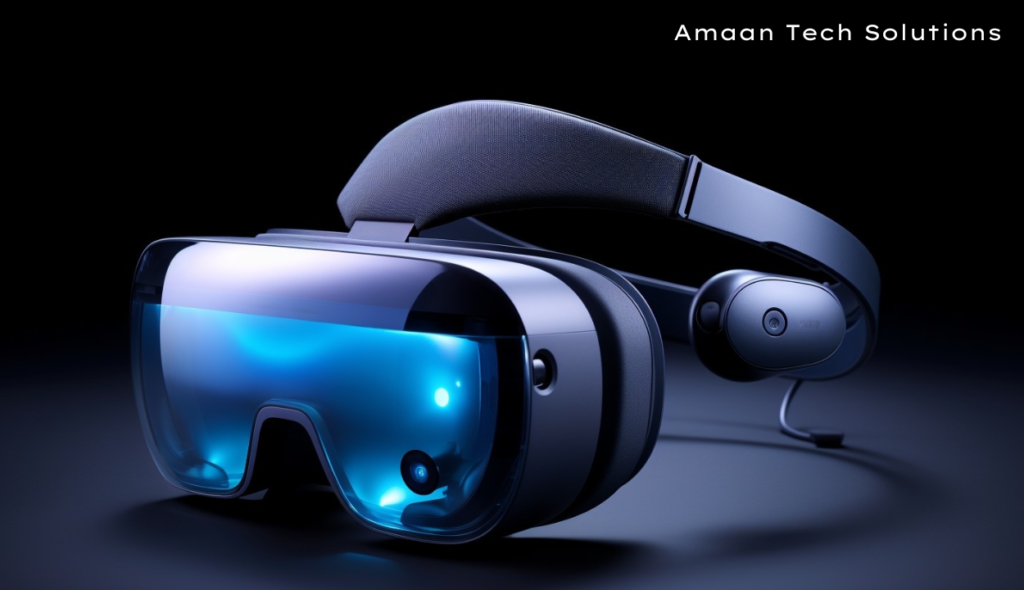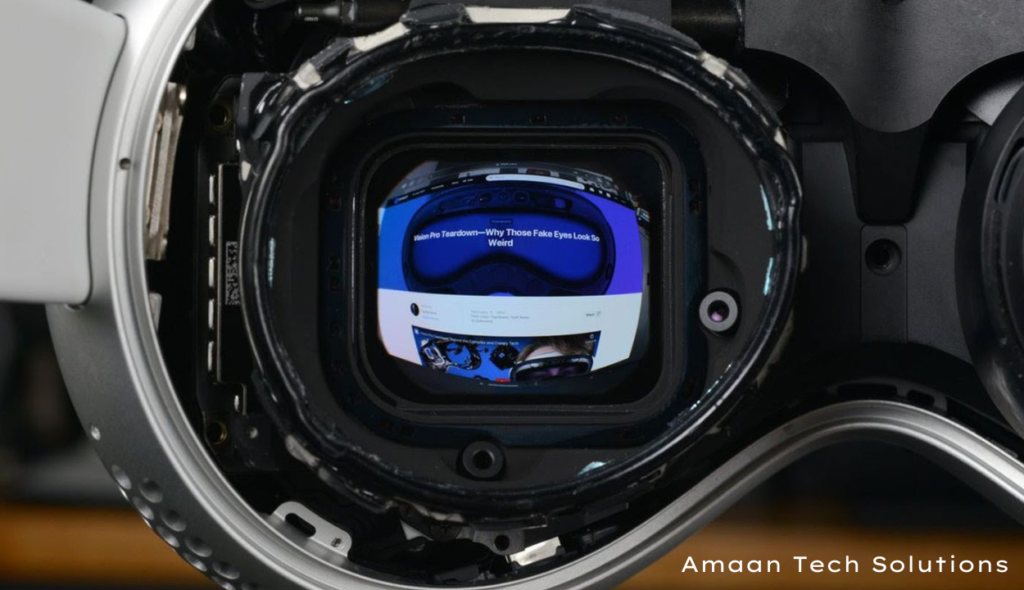
Introduction For Apple Vision Pro Vs Samsung
Choosing the right tech tool may be problematic, especially with so many alternatives to be had. Today, we’re evaluating main merchandise: the Apple Vision Pro and Samsung’s pinnacle competitor. Both brands are recognised for their revolutionary era and first-class products, but they have unique functions that cause them to stand out.
In this comparison, we will examine the key factors of every tool, including design, overall performance, and unique functions, to help you decide which one is probably the nice match for you. Whether you are a fan of Apple’s glossy designs or Samsung’s effective generation, there is something here for every body. Let’s dive in.
Apple Vision Pro And Samsung AR Glasses
Apple’s Vision For AR
You’ve heard the rumors, and now it’s legitimate – Apple has unveiled its first augmented truth headset, the Vision Pro. This sleek tool blends current AR with Apple’s signature layout and consumer revel in.
Powered with the aid of a custom Apple silicon chip and advanced eye-tracking tech, the Vision Pro gives you stunningly sensible augmented visuals seamlessly mixed together with your bodily surroundings. Whether you are gaming, running, or simply exploring apps, the spatial computing capabilities promise an immersive enjoy like by no means before.
Samsung’s Galaxy AR Glasses
Not to be outdone, Samsung has also entered the AR area with their very own Galaxy AR glasses. More light-weight and compact than the Vision Pro, those specs purpose to combine augmented visuals into your normal life.
With transparent OLED displays and spatial tracking, Samsung’s presenting lets digital overlays coexist with your real-world view. From AR navigation to immersive gaming and productivity equipment, those glasses should redefine how we engage with our gadgets and environments.
The AR Revolution Begins
Both Apple and Samsung are having a bet huge that AR may be the subsequent essential computing platform after smartphones. Their respective headsets constitute vastly exclusive visions – the Vision Pro as a premium combined truth revel in, and Samsung’s take on pragmatic, portable AR.
As these enterprise titans conflict for AR supremacy, one element’s for positive – augmented fact is now not technological know-how fiction. The line between digital and bodily worlds is blurring, ushering in new frontiers of immersive computing. Whether you are crew Apple or team Samsung, get geared up for truth to tackle a whole new size.

Key Features And Specs Comparison
Let’s dive into the juicy information and spot how these augmented truth glasses stack up against each different. Buckle up, folks – it will be a wild journey.
Displays
Apple’s Vision Pro boasts 4K micro OLED displays with a discipline of view of one hundred twenty levels. On the alternative hand, Samsung’s providing sports activities dual QLED panels with a slightly narrower one hundred-diploma discipline of view. Both promise immersive visuals, but Apple’s wider field of view would possibly give you that extra bit of virtual real property.
Performance & Chips
The Vision Pro packs a critical punch with Apple’s custom M2 chip, designed especially for mixed truth reports. Samsung, however, is rumored to be the use of Qualcomm’s modern-day Snapdragon XR2 Gen 1 chip. While both promise smooth performance, Apple’s custom silicon should probably give it an edge.
Battery Life
This is in which things get a piece tricky. Apple claims the Vision Pro can last as long as 2 hours on a unmarried rate, whilst Samsung’s glasses are said to provide round 3-four hours of use. Of direction, real-global usage will range, but Samsung’s supplying might be the manner to head if you’re making plans prolonged virtual adventures.
Tracking & Sensors
Both companies have pulled out all the stops when it comes to tracking and sensors. The Vision Pro sports an impressive array of cameras, depth sensors, and eye-tracking tech for precise environmental mapping and gesture control. Samsung is also packing a bunch of sensors, but details are still a bit hazy.
Design & Comfort
Apple’s Vision Pro looks sleek and futuristic, with a curved visor and lightweight aluminum frame. Samsung’s design, while still under wraps, is rumored to be more compact and potentially easier to wear for extended periods. Comfort is key when you’re exploring virtual worlds, so this could be a deciding factor for some.
Price & Availability
Brace yourselves – these current devices may not come reasonably-priced. Apple’s Vision Pro is predicted to retail for a fab $three,499 while it launches early subsequent yr. Samsung’s pricing continues to be a thriller, but rumors endorse it is able to undercut Apple’s offering by some hundred bucks. Of path, these are simply whispers in the wind for now.
So, there you have it – a brief rundown of ways these augmented reality glasses examine on paper. But as with all new tech, the real check might be how they carry out in the wild. Stay tuned for extra updates as we get towards release.

Display Quality And Field Of View
Cutting-Edge Displays
Both Apple and Samsung have pulled out all the stops on the subject of their AR glasses’ displays. You’ll be blown away via the crystal-clear visuals and colourful colorations. Apple’s Vision Pro boasts an excellent 4K micro OLED display that gives you razor-sharp text and graphics. Meanwhile, Samsung’s providing functions a sophisticated QLED panel that promises deep blacks and eye-popping brightness ranges.
Expansive Field Of View
One of the most important components of any AR enjoy is the field of view (FOV) – the vicinity in which virtual objects are projected. A slender FOV can experience claustrophobic and disconnected from the actual global. Both tech giants have aimed high right here, with Apple’s Vision Pro promising an industry-main one hundred twenty-degree diagonal FOV. Samsung is not a long way in the back of with a 100-diploma FOV that must nevertheless offer an immersive augmented truth.
Seamless Blending
But it’s not just about raw specs. These displays are designed to seamlessly blend digital content with your surroundings. Apple touts advanced optics that minimize visual aberrations, while Samsung claims its lenses offer a more natural viewing experience. Whichever you choose, expect virtual objects to feel like they’re part of the real world around you.
Optimal Viewing Comfort
Long AR sessions can strain your eyes, so both companies have implemented features to reduce fatigue. The Vision Pro offers dynamic dimming to match brightness levels, while Samsung uses advanced eye-tracking to optimize rendering. You’ll be able to stay focused and comfortable, whether you’re gaming, working, or just exploring augmented environments.

Camera And Sensors
When comparing the camera and sensor capabilities of Apple’s Vision Pro and Samsung’s AR glasses, there are some key factors to consider. You’ll want to dive into the specs to see which device offers the most impressive augmented reality experience.
Advanced Optics And Sensors
Both companies have poured extensive research into developing cutting-edge optics and sensors tailored for AR. Apple is touting its custom waveguide lenses and advanced Eye Tracking system to deliver stunningly realistic visuals. Samsung, meanwhile, is said to be leveraging its expertise in OLED displays and LIDAR sensors for seamless digital overlays.
The quality and precision of these optical components will be crucial for immersive AR that doesn’t cause eye strain or discomfort during extended use. Early reviews will likely scrutinize this aspect closely.
High-Resolution Cameras
Another key factor is the outward-facing cameras used for environmental mapping and anchoring virtual objects convincingly in the real world. Leaks suggest Apple’s Vision Pro packs an impressive 12MP camera array, while Samsung may opt for higher megapixel counts.
More megapixels doesn’t necessarily translate to better AR, however. The computational photography algorithms, camera sensor sizes, and overall image processing capabilities will play a vital role too. Smooth hand tracking and accurate environmental understanding are essential for intuitive AR interactions.
Power-Efficient Sensor Fusion
Of direction, packing all those superior sensors into a light-weight headset is an engineering task in itself. Both Apple and Samsung will want to finely track their sensor fusion algorithms to balance accuracy with battery performance.
Rumors indicate Apple’s M2 chip could supply it an aspect here, with its enterprise-leading performance consistent with watt. But Samsung’s semiconductor prowess can’t be underestimated. Thermal management could be key – neither company wishes a headset that gets uncomfortably hot during use.
Ultimately, the pleasant of the augmented fact visuals, environmental knowledge, and standard enjoy will come right down to flawless integration of cameras, sensors, optics, and silicon. It’s a daunting venture, but one that would separate the leaders from the p.c In this new frontier of computing.

Battery Life And Charging
Longer Usage Time
No one wants their AR glasses dying halfway through an important task or fun experience. That’s why you’ll want to keep an eye on battery life. Both Apple and Samsung are touting impressively long usage times for their new AR glasses. Apple claims its Vision Pro can last up to 2 hours with continuous active use. And Samsung says its model can hit 3.5 hours on a single charge.
That said, actual battery life will vary based on what apps and features you’re using. Things like video calls, gaming, and AR effects will drain the battery faster than basic tasks. So plan accordingly if you want sustained AR immersion.
Fast Charging Capabilities
When it’s time to power up, both companies offer fast charging options to quickly get you back in the AR action. Apple’s Vision Pro can regain around 50% battery in just 30 minutes with its special charging cable. Not too shabby if you’re in a hurry.
Samsung goes even faster. Their charging case can rapidly recharge the glasses from 0 to 50% in just 20 minutes! It’s like a portable, high-speed charging station for pit stops. That kind of quick top-up could be a game-changer.
Wireless Charging Convenience
But what if you don’t have the charging cable handy? No worries, wireless charging pads have you covered for both models. Simply set your AR glasses on the included wireless charging pad to juice them up cord-free.
It’s a smooth, convenient way to keep them powered without extra cable clutter. Just pop them on the pad when you’re done using them each day. By morning, you’ll have a freshly charged headset ready to go.
Power Management Features
Of course, hardware is only half the battle for great battery life. Both Apple and Samsung have built-in smart power management features into their AR operating systems. This optimizes performance and helps stretch out each charge cycle.
For example, automatic battery saver modes can dial back processing power and display brightness when the battery gets low. That way, your glasses won’t just suddenly die on you. You’ll get ample warning to find a charging spot.

Design And Comfort
Here’s A Table Comparing The Features Of Apple And Samsung’s Augmented Reality Glasses Based.
| Feature | Apple Vision Pro | Samsung AR Glasses |
|---|---|---|
| Design | Curved visor, lightweight aluminum frame, minimalist yet premium vibe | Angular, cyberpunk-inspired design |
| Ergonomics | Balanced weight distribution, adjustable headband | Adjustable nose pads and temple tips |
| Audio | Spatial audio adapts to head movements | Advanced audio capabilities, leveraging expertise in audio technology |
| Hand Tracking and Controls | Advanced sensors, machine learning for hand gesture interpretation | Likely similar hand-tracking capabilities, inspired by smartwatch and smartphone interfaces |
This Table Outlines The Key Aspects Of Each Product, Highlighting Their Design, Ergonomic Features, Audio Capabilities, And Input Methods.
Supported Apps And Content
With augmented reality (AR) being the next frontier in consumer technology, the apps and content supported by Apple’s Vision Pro and Samsung’s AR glasses will be a key differentiator. Let’s dive into what we can expect from these powerhouse brands.
Immersive Experiences
Both corporations are doubling down on immersive AR studies that blur the road between digital and physical worlds. You can count on thoughts-bending games, interactive studying gear, or even virtual workspaces that can help you multitask like a md.
Imagine playing an epic RPG wherein monsters bounce off the screen or attending a digital lecture where 3-D fashions glide before your eyes. The possibilities are limitless when pinnacle developers unharness their creativity on these modern systems.
Productivity Boost
But AR isn’t just about fun and games. These headsets promise to revolutionize how we work by overlaying digital information onto our surroundings.
With Apple’s suite of productivity apps like Pages and Numbers optimized for spatial computing, you could have multiple virtual screens at your fingertips. And Samsung’s partnerships with Microsoft and Google suggest seamless integration with popular office tools.
No more squinting at tiny laptop screens – your entire room could become an ultra-wide workspace tailored to your needs.
Entertainment Galore
When you’re ready to kick back, both ecosystems will offer a treasure trove of AR movies, shows, and live events. Imagine watching the big game with stats and commentary hovering around the field or experiencing a blockbuster with characters leaping into your living room.
With their deep pockets and content partnerships, Apple and Samsung are poised to bring Hollywood-level production values to these immersive experiences. The couch potato life just leveled up.
While details are still emerging, one thing’s clear: the app and content offerings for these AR glasses will reshape how we play, work, and consume media. It’s an exciting frontier, and the battle between tech titans is just getting started.

Pricing And Availability
Luxury Price Tags
When it involves modern augmented fact (AR) headsets, you can anticipate sky-excessive charges. Both Apple and Samsung’s trendy services cater to the top class segment. The Apple Vision Pro will set you returned a cool $three,499 while it launches in early 2024. Not to be outdone, Samsung is rumored to rate its AR glasses round $1,800 – nonetheless an eye fixed-watering amount for maximum customers.
These exorbitant price tags reflect the immense R&D costs and advanced technologies packed into these futuristic wearables. From powerful processors to high-resolution displays and advanced sensors, no expense has been spared.
Limited Initial Availability
Like most current products, availability can be extremely limited while those AR glasses first hit the marketplace. Apple has already warned that Vision Pro substances might be constrained at launch. Meanwhile, Samsung is anticipated to produce just a few hundred thousand devices initially.
This shortage is partly due to deliver chain demanding situations and production complexities. But it’s also a strategic move to build hype and exclusivity across the first AR headsets aimed at the mass client marketplace. Early adopters and die-difficult fanatics will likely be the simplest ones able to get their fingers on these gadgets in 2023.
A Glimpse Into The Future
While pricing and availability seem daunting now, don’t forget that those are first-era products ushering in a new generation of immersive computing. Just like early smartphones, charges will inevitably come down because the era matures and economies of scale kick in.
For now, these AR glasses represent an exciting but luxurious glimpse into the future of personal computing. Only people with deep pockets can find the money for to be at the bleeding fringe of innovation. But rest confident, AR is here to live – and it will most effective end up extra accessible through the years.

Frequently Ask Questions About Apple And Samsung’s AR Glasses
What Are AR Glasses ?
Augmented fact (AR) glasses are wearable gadgets that overlay virtual statistics and visuals at the real global you see in the front of you. Unlike virtual fact (VR) headsets that immerse you in a completely digital surroundings, AR glasses keep you grounded within the physical global even as improving it with virtual elements.
How Will They Work ?
Both Apple’s Vision Pro and Samsung’s upcoming AR glasses will use superior cameras, sensors, and displays to map your environment and mission three-D pictures that appear anchored to real-international gadgets and surfaces. You’ll be able to view interactive digital content even as nonetheless seeing and interacting with your real surroundings.
What Can You Do With Them ?
The potential use cases are vast – from visualizing 3D models and product designs to getting immersive directional guidance. You can play games, watch videos, and attend virtual meetings that feel like holographic projections in your living room. The devices aim to blur the lines between the digital and physical realms.
Are They For Consumers Or Professionals ?
Initially, both companies seem to be targeting a mix of professionals and early adopters. Apple is emphasizing the Vision Pro’s creative and productivity potential for fields like engineering, 3D design, and healthcare training. Samsung may focus more on AR experiences for gaming, media consumption, and social interactions.
How Much Will They Cost ?
Apple’s Vision Pro is expected to hold a hefty $three,499 beginning charge whilst it launches in early 2024. Samsung hasn’t announced pricing but, however leaks advise their glasses can be greater affordable in the $800-$1,two hundred range to appeal to a much broader client base.
When Can I Get Them ?
The Apple Vision Pro has a scheduled release window of early 2024 for the US marketplace. Samsung is rumored to unveil their AR glasses later this year, potentially beating Apple to market, but concrete launch timelines are nonetheless unsure for each merchandise.

Conclusion
- So there you have got got it, a rundown of the maximum exciting new AR glasses slated for release this 12 months.
- With Apple and Samsung combating it out to dominate the AR location, 2023 is shaping as lots as be a pivotal 12 months.
- Only time will tell whether or not Apple’s luxurious tool or Samsung’s inexpensive mainstream model will come out on pinnacle. But one factor’s for sure – AR is set to get a whole lot extra thrilling.
- We can’t wait to go fingers-on with these slick new wearables and discover virtual worlds layered over our own.
- The future is unfolding in advance than our eyes.

Amaan Warraich is a tech fanatic and creator enthusiastic about exploring the ultra-modern advancements in technology. With a background in laptop technological know-how, Amaan delves into topics ranging from synthetic intelligence to cybersecurity, aiming to make complex concepts accessible to all. Through his paintings, he strives to encourage interest and innovation inside the ever-evolving global of generation.

